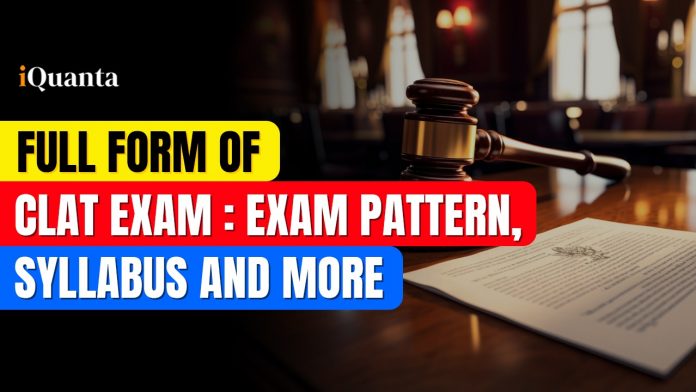The Common Law Admission Test (CLAT) is a pivotal examination for aspiring law students in India, serving as the gateway to 24 National Law Universities (NLUs) and numerous other prestigious law schools. In 2023, the CLAT exam witnessed approximately 70,000 candidates vying for approximately 3,000 seats across these institutions, highlighting its competitive nature. As we approach the 2025 examination cycle, it becomes crucial for candidates to stay informed about registration processes, exam dates, and syllabus details.
In this article, we will explore essential aspects like the full form of the CLAT exam, registration timelines, eligibility criteria, and preparation strategies. Whether you are a first-time applicant or looking to improve your previous score, this comprehensive guide will equip you with all the necessary information to succeed in the upcoming CLAT exam.
Full Form of CLAT Exam
The first thing you should know is What is the full form of the CLAT exam?
The CLAT stands for the Common Law Admission Test. This examination evaluates candidates’ skills in legal reasoning, logical reasoning, English language proficiency, general knowledge, and quantitative techniques.
The CLAT exam is a national-level entrance test conducted by the Consortium of National Law Universities (NLUs). It assesses candidates’ aptitude for legal education and is crucial for securing admission into undergraduate (UG) and postgraduate (PG) law programs. The exam format includes multiple-choice questions covering various subjects relevant to legal studies.
CLAT 2025 Highlights
The CLAT exam is held for admission to legal programs provided by 24 NLUs in India. CLAT is one of the country’s most crucial and rigorous legal entrance tests. More than one lakh students will likely take the CLAT exam this year. 97.03% of the applicants who registered for the CLAT 2024 Undergraduate test and 93.92% of those who enrolled for the CLAT 2024 Postgraduate test took the exam.
Therefore, students must understand the exam’s major elements, which are listed in the table below:
| Features | Ongoing |
|---|---|
| Full Form of CLAT exam | Common-Law Admission Test |
| Popularly known as | CLAT |
| Conducting Body | The Consortium of National Law Universities (NLUs) |
| CLAT Exam Date | December 2024 |
| Exam mode | Pen-and-paper exam |
| Exam duration | Two hours |
| Number of seats | For UG courses – 3,213, and PG courses – 1,217 (Not including sponsored, supernumerary, NRI, and extra seats.) |
| Accepting colleges | 24 participating NLUs and 61 private law colleges |
| Top-ranked participating NLU | Here are the top-ranking participating NLUs as per NIRF Ranking 2023NLSIU Bengaluru – Rank 1NALSAR – Rank 3WBNUJS Kolkata – Rank 4 |
| Official website | https://clatconsortiumofnlu.ac.in/ |
Detailed Syllabus for CLAT 2025
The syllabus for the CLAT exam encompasses five primary subjects:
- English Language: The English Language section includes reading comprehension passages and related questions, focusing on candidates’ language proficiency and comprehension skills.
- Current Affairs and General Knowledge: The Current Affairs and General Knowledge section tests candidates’ awareness of recent events at both national and international levels.
- Legal Reasoning: The Legal Reasoning section assesses candidates’ ability to understand legal principles and apply them to various scenarios presented in the exam.
- Logical Reasoning: The Logical Reasoning section evaluates candidates’ analytical skills through various logical problems, including puzzles and reasoning questions.
- Quantitative Techniques: The Quantitative Techniques section tests basic mathematical skills, including problem-solving abilities related to numerical data.
The following table summarises the weightage of each subject in the CLAT 2025 exam:
| Subject | Number of Questions | Weightage (%) |
|---|---|---|
| English Language | 28-32 | 20% |
| Current Affairs & General Knowledge | 35-39 | 25% |
| Logical Reasoning | 28-32 | 20% |
| Legal Reasoning | 35-39 | 25% |
| Quantitative Techniques | 13-17 | 10% |
| Total | 120 | 100% |
CLAT LLM Syllabus 2025
Candidates can check the CLAT LLM 2025 syllabus below:
- Constitutional Law (fundamental rights, separation of powers, and judicial review)
- Jurisprudence
- Administrative Law
- Law of Contract
- Torts, Family Law
- Criminal Law (definitions of crimes, defenses, and criminal procedure)
- Property Law
- Company Law
- Public International Law
- Tax Law
- Environmental Law
- Labour & Industrial
The CLAT LLM typically consists of 120 multiple-choice questions with a negative marking scheme (0.25 marks deducted for each incorrect answer).
Overview of CLAT Exam Pattern
The CLAT exam pattern has been designed to assess various skill sets necessary for legal studies. The examination consists of 120 multiple-choice questions that must be completed in two hours. Each correct answer awards one mark, while incorrect answers incur a penalty of 0.25 marks.
The structure of the examination can be summarised as follows:
- Exam Mode: Offline (pen-and-paper)
- Duration: 2 hours
- Total Questions: 120
- Negative Marking: Yes (0.25 marks deducted for each incorrect answer)
| Category | UG program | PG program |
|---|---|---|
| Duration | Two hours | Two hours |
| Mode | Offline mode | Offline mode |
| Type of Questions | Objective-type, passage-based questions | Objective-type, passage-based questions |
| Number of Questions | 120 question | 120 |
| Subjects | Constitutional LawOther Law Subjects include Contract, Torts, Criminal Law, International Law, IPR and Jurisprudence. | Constitutional LawOther Law Subjects including Contract, Torts, Criminal Law, International Law, IPR and Jurisprudence. |
| Total Marks | 120 marks | 120 marks |
| Marking Scheme | +1 mark for the correct answer-0.25 marks for an incorrect answer. | +1 mark for the correct answer-0.25 marks for an incorrect answer. |
Eligibility Criteria for CLAT 2025
Candidates must meet specific eligibility criteria to apply for the CLAT exam. These criteria vary slightly between undergraduate and postgraduate programs:
For CLAT UG Programme:
- Completed Class 12 or equivalent with at least 45% marks (40% for SC/ST candidates).
- No upper age limit.
| Criteria | Requirements |
|---|---|
| Educational Qualifications | Class 12 or equivalent exam with at least 45% marks (40% for SC and ST categories) |
| Age Limit | There is no age limit for taking the CLAT exam. |
| Minimum marks | General – 45%SC/ST – 40% |
| Number of attempts | No limit (Candidates who appeared for CLAT 2024 can also appear in CLAT 2025) |
For CLAT PG Programme:
- A valid LLB degree or equivalent with at least 50% marks (45% for SC/ST candidates).
- No upper age limit.
| Criteria | Requirements |
|---|---|
| Educational Qualifications | The candidate must have passed the 5-year integrated or 3-year LLB exam. |
| Age Limit | There is no age limit for taking the CLAT exam. |
| Minimum marks | General – 50%SC/ST – 45% |
| Number of attempts | No limit (Candidates who appeared for CLAT 2023 can also appear in CLAT 2024) |
Note: The eligibility conditions for associated institutions may differ from those indicated above; thus, you should visit the relevant university’s website for the most up-to-date information.
Additionally, candidates appearing in their final year of qualifying examinations are eligible to apply, provided they submit proof of passing at the time of admission.
Important Dates for CLAT 2025
The timeline for the CLAT exam is crucial for candidates planning their preparation strategy. Here are the significant dates:
| Event | Date |
|---|---|
| Registration Start Date | July 15, 2024 |
| Registration End Date | October 15, 2024 |
| CLAT Exam Date | December 1, 2024 |
| Admit Card Release | Late November 2024 |
| Result Announcement | December/January |
Candidates should adhere strictly to these dates to ensure timely registration and preparation.
Step-by-step Guide to the CLAT Application Process
The application process for the CLAT exam involves several steps:
- Registration: Candidates must create an account on the official CLAT website.
- Filling Out the Application Form: Provide accurate personal and educational details.
- Document Uploads: Upload required documents in specified formats and sizes, such as photographs and signatures.
- Selecting Exam Centres: Choose preferred centres from the list provided.
- Payment of Fees: Pay the application fee online.
The application fees for CLAT 2025 are as follows:
- General/OBC/PwD candidates: ₹4,000
- SC/ST/BPL candidates: ₹3,500
Candidates wishing to obtain the previous year’s question papers will incur an additional charge of ₹500.
Importance of Mock Tests in CLAT Preparation
Mock tests play a vital role in preparing for the CLAT exam. They help candidates familiarise themselves with the exam format and time constraints while identifying strengths and weaknesses in their preparation strategy. Regularly taking mock tests can significantly enhance performance by improving time management skills and boosting confidence.
Strategies to Kickstart Your CLAT Preparation
To effectively prepare for the CLAT exam, consider implementing these strategies:
- Create a Study Schedule: Develop a well-organized study plan that allocates time for each subject based on its weightage in the exam.
- Utilise Quality Study Material: Invest in updated books and online resources specifically designed for CLAT exam preparation.
- Join Study Groups or Coaching Classes: Collaborating with peers or enrolling in coaching can provide additional support and motivation.
- Regular Revision: Consistently revisiting topics ensures better retention of information.
Check How to prepare for CLAT exam, for more info on prep strategy
Admit Card Details for CLAT 2025
The admit card is a crucial document required to appear for the CLAT exam. Candidates can download their admit cards from the official website approximately two weeks before the examination. It is essential to carefully check all details on the admit card; discrepancies should be reported immediately.
Conclusion
Preparing for the CLAT exam requires diligence, strategic planning, and understanding key components such as registration processes, eligibility criteria, and syllabus details. With registrations now open until October 15, 2024, aspiring law students should take advantage of this time to prepare thoroughly.
By following this comprehensive guide on CLAT Exam 2025, candidates can enhance their chances of success in this competitive examination and secure their place in one of India’s esteemed law universities.


